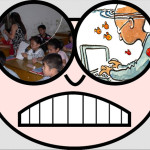
February 28, 2018
Why Blended Learning Fits Your Class, 3 Issues to Think About, and 5 Easy Ways to Begin
 For years, my teaching revolved around textbooks as my resources. When the Internet arrived, I — as did my colleagues — adopted it mostly for two reasons: 1) research — in place of the library, and 2) rote drills, such as supporting math practice. But that has changed. Using the Internet in classrooms has morphed from optional to organic. In fact, it’s transformed 21st-century education, offering a normative tool for adapting to varied student needs, a scalable approach to differentiating for student learning styles, and a collaborative must-have with its vast offering of virtual meeting and storage options. It is regularly called the “present and future of education”, “one of the central features of modern school reform”, and “the newest way to personalize education”.
For years, my teaching revolved around textbooks as my resources. When the Internet arrived, I — as did my colleagues — adopted it mostly for two reasons: 1) research — in place of the library, and 2) rote drills, such as supporting math practice. But that has changed. Using the Internet in classrooms has morphed from optional to organic. In fact, it’s transformed 21st-century education, offering a normative tool for adapting to varied student needs, a scalable approach to differentiating for student learning styles, and a collaborative must-have with its vast offering of virtual meeting and storage options. It is regularly called the “present and future of education”, “one of the central features of modern school reform”, and “the newest way to personalize education”.
For many teachers, it’s fundamental to a style of teaching called “blended learning” (sometimes referred to as “hybrid learning” or even “flipped classroom”). Blended learning occurs when an education program combines Internet-based media with traditional classroom methods. For example, a unit on space is supported by a virtual chat with an astronaut from the space station or his Houston training facility. What used to require school buses and lots of time now is accomplished more effectively for less money through the Internet.
But blended learning is more than simply replacing lectures and books with web-based technology. If you follow the SAMR model, this type of substitution is the lowest level of the pyramid. When technology is mixed agilely with traditional teaching methods to deliver a more rigorous, more purpose-built program, it moves your class to the top SAMR levels — Modification and Redefinition — by replacing less-effective approaches (like pictures) with more-authentic methods (like a virtual visit to a zoo).
Here are three of the most popular reasons why schools adopt blended learning:
- provide students with control over the time, place, path, and pace of learning
- differentiate for varied student needs by providing a variety of approaches to achieve a goal
- save teacher time because s/he can automate instruction where possible using tech tools
What sounds like a no-brainer, like something any educator would want to do, is not without problems. Here are three that schools face:
Teacher training
Becoming comfortable with the digital tools that make blended learning possible can be intimidating to teachers, trainers, and even administrators. “Technophobia” is real and prevents many educators from adopting anything other than the most intuitive, problem-free digital tools. When you commit to a blended learning program in your school, establish an organic and on-going training program, hand-holding as needed, to help teachers change their traditional mindset.
Infrastructure
Because blended learning moves many lesson resources online, schools need dependable digital devices, a reliable infrastructure that supports the volume of access, and a knowledgeable IT staff to assist in the early stages and prevent frustrations. These should be in place before unpacking a blended learning program.
Online Course delivery system
Effectively blending web-based tools with traditional requires an organized online method to share resources. This is a two-step process. First, establish a Learning Management System (LMS) that will help teachers accomplish daily classroom tasks (those outside of teaching students) such as grading, homework assignment, collection of classwork, student discussions, parent interaction, attendance, and an online class calendar. There are a wide variety of LMSs from free programs like Otus to freemium offerings like Canvas. The one you select will depend upon your unique needs and budget.
Once teachers are comfortable managing class activities in the cloud, move to the next step: Make lesson plans available in one central, easy-to-reach location such as the free Wikispaces or fee-based Blackboard. When lesson plan resources (i.e., videos, links, and audio) are available online, students can access them according to their schedules and location. They become rewindable, dynamic, and responsive to student needs.
———————————————
When you’re ready to blend the Internet into your lesson plans, a good approach is to roll out five tools in the first year. Just five. Get used to these digital tools across the school year, across subjects if you’re a multi-subject teacher. Let students get comfortable with how they work, how they extend learning, and how they add to the communication of knowledge. Let student own them, willingly use these tools even without your suggestion, because they understand how they assist learning.
Here are five digital tools that will blend learning with the least amount of problems and the greatest amount of success:
Virtual experts
freemium
Inviting experts to visit students virtually means you have access to a wide-range of speakers your classes wouldn’t normally be able to access. Through sites like Nepris, you make all the arrangements online, meet virtually on your class computer, and interact just as you would if you trundled everyone onto a bus, motored up the freeway in rush hour traffic, and shepherded everyone on a tour hoping no one got lost. Virtual meetings are easier, more respectful of everyone’s time, and more cost-effective for all stakeholders.
Khan Academy
free
Khan Academy’s well-regarded virtual math program allows students to learn at their own pace, rewind as needed, and ask for help when necessary, without the false boundaries of a grade-level textbook that tells them what they must learn and when. Students start with an assessment to determine where they are in their math learning and move forward from there.
CK-12 Flexbooks
free
CK-12 offers digital textbooks and learning materials in primarily STEM subjects that are searchable by curriculum or concept and can be arranged to suit student needs and interests. Resources include videos, lesson plans, and more, and can be rolled out for a complete year or shorter periods as needed. Digital books are aligned with state standards and Common Core.
Student blogs
any platform; free/fee
Blogs are invaluable digital tools for teaching writing skills as well as developing speaking and listening habits necessary to succeed in life. Because posts and comments are easily shared, they provide formative feedback on what students have learned. A wide variety of media can be included, such as videos, audio, PDFs, and more. They are suitable for students as young as third grade and as old as adults by adapting platforms used and expectations.
Options include WordPress, Kidblog, Wix, and Google’s Blogger.
Communication Tools
vary, many free
Communication tools include all those digital ways teachers encourage students to communicate their thoughts and provide evidence of learning to both teachers and classmates. It can mean a class backchannel (such as Today’s Meet and Twitter) where students ask clarifying questions and teachers assess understanding. It can also mean outside-of-class tools such as chatrooms, discussion boards, or blogs where students discuss a specific topic. A more robust option is a virtual meeting via programs like Skype or Google Hangouts where students plan projects or study for exams and teachers offer one-on-one tutoring or chat with parents.
***
These five digital tools are a great start to a blended learning program. Roll them out one at a time or all at once. Quickly, you’ll find the delivering education in a blended way tells students you value their time by using tools that are relevant, effective, and fast.
–published first on TeachHUB
More on blended learning
Blended Learning 101: An Introduction to Blended Learning Instruction
Must-have Resources for Blended Learning
Use the SAMR Model to Spearhead Technology in Your Classroom
Jacqui Murray has been teaching K-8 technology for 20 years. She is the editor/author of over a hundred tech ed resources including a K-8 technology curriculum, K-8 keyboard curriculum, K-8 Digital Citizenship curriculum. She is an adjunct professor in tech ed, CSG Master Teacher, webmaster for four blogs, an Amazon Vine Voice reviewer, CAEP reviewer, CSTA presentation reviewer, freelance journalist on tech ed topics, and a weekly contributor to TeachHUB. You can find her resources at Structured Learning. Read Jacqui’s tech thriller series, To Hunt a Sub and Twenty-four Days.






